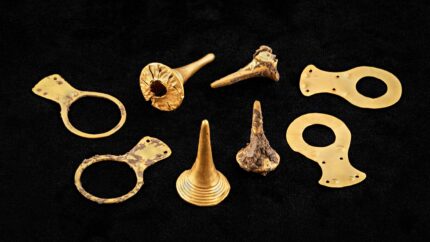Archaeologists have discovered more than a dozen gold artifacts in three Copper Age graves at the Bükkábrány lignite mine in northeast Hungary. About 6,000 years old, these artifacts date to the early centuries of goldsmithing in Europe. The oldest gold jewelry in the world found in the Varna Necropolis, on the Black Sea coast of Bulgaria, dates to between 4,600 and 4,200 B.C., six to two hundred years before the Bükkábrány pieces.
The mine site has been excavated since 2007 when large trunks of swamp cypress from the Miocene era were discovered not petrified, but mummified from having been encased in sand eight million years ago. A natural valley formed by the Csincse river, the area has seen human occupation from the Neolithic to the Middle Ages. There is archaeological evidence of millennia of human settlement, including communities from the middle Copper Age Bodrogkeresztúr culture. The latest excavation unearthed 34 Bodrogkeresztúr-era graves, identified by the characteristic pottery style.
Most of the graves were modestly furnished, but three adult women were buried with prestigious gold ornaments. The gold objects found inside the three graves include hooped and conical pendants. The hoops are tabbed with four holes in each tab. Archaeologists believe they may have originally been mounted onto a headdress. Gold was still extremely rare in the Carpathian Basin at this time and while similar pieces have been discovered at other Copper Age sites, these objects are exceptional for the quality of gold and craftsmanship.
A fourth burial of note did not have any gold artifacts, but contained the remains of an adult man buried with a cracked stone blade, a polished stone axe and copper pick weighing two pounds. The pick was almost certainly not a practical implement. That much metal weight would have been exorbitantly expensive and it was probably more of a leadership symbol like a scepter than a tool.
It is not clear from the style of manufacture whether the objects were made locally or imported. They will be studied further and conserved at the Herman Ottó Museum in Miskolc.

They look sort of like pull tabs! Aszú souvenirs from a party?
Yeah, pull tabs indeed. On the other hand, they seemingly were stitched onto something, maybe some textile or leather.
Hard to tell if those ‘cones’ were mounted anywhere, but apparently we have four shiny connections and a lot of bling ling. Maybe, something that was used in horse riding or indeed a party dress.
I need more context 😆
“Ann. Naturhistor. Mus. Wien”, Nr.70, pp.491-496, Wien, Oct. 1967:
——–
zobodat.at/pdf/ANNA_70_0491-0496.pdf
——–
Have a look at p.3 in the pdf (p.493, “Abb.1”, “Ringanhänger from different locations”).
Back in 1967, they were referred to in Vienna as “Ringanhänger” (ring pendants).
:hattip:
———-
Allegedly, the “Stollhof hoard” had been a “depot hoard from the Stollhof area” that was bought in 1876. “Ringanhänger” might be useful in camping and tent construction, but presumably not even in the Copper Age in Gold. 😎
Both, the rings and the cones were as pendants part of a headdress according to the museums website. All these artifacts were found next to the temple of the womens heads, and earlier there were similar burials at other sites from the same era with similar artifacts, as well.
Unfortunately, no pictures and no info given on sizes and those “stitch” holes whatsoever, but there is an entry for “Bodrogkeresztur“, cf.:
donau-archaeologie.de/doku.php/kulturen/bodrogkeresztur_english_version#find_material
———-
“…The most common jewellery items are stone pearls (Patay 1974, 15-19). They often come up in several hundreds, mostly in women’s graves. Boars’ tusks can be found only in men’s graves, they seem to be a heritage from the Neolithic and the early Copper Age. The most important metal jewellery items are disc-shaped or ring-shaped pendants. They can be traced back as far as the early Copper Age and are very similar to those from the Balkans or the Aegean. Mostly they are made from gold which is used more often than copper as a raw material for making jewellery. Beside pendants, people wore golden pearls, buttons, rods, rings and bracelets. In addition, we find spondylus pearls which demonstrate contacts to the Adria (Szabó 1997, 53). …”
———-
Additionally:
cambridge.org/core/services/aop-cambridge-core/content/view/C6CE723D842D5A81E6551924621D8838/S0033822220001150a.pdf/culture-period-or-style-reconsideration-of-early-and-middle-copper-age-chronology-of-the-great-hungarian-plain.pdf
:hattip: